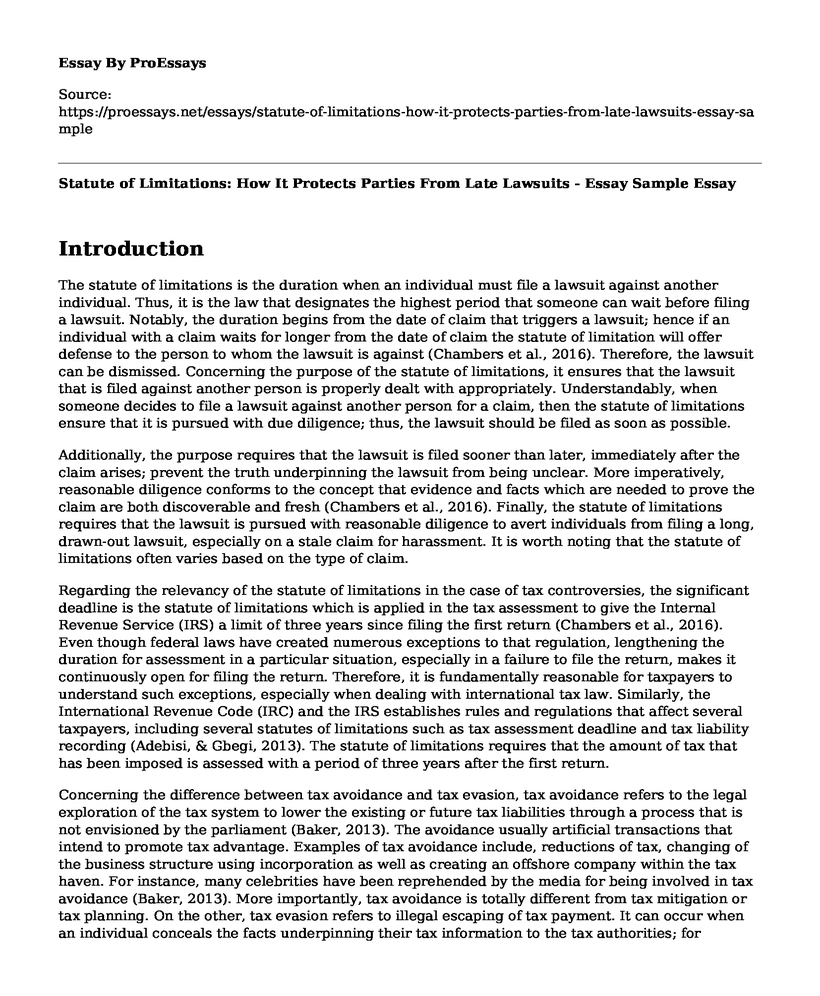Introduction
The statute of limitations is the duration when an individual must file a lawsuit against another individual. Thus, it is the law that designates the highest period that someone can wait before filing a lawsuit. Notably, the duration begins from the date of claim that triggers a lawsuit; hence if an individual with a claim waits for longer from the date of claim the statute of limitation will offer defense to the person to whom the lawsuit is against (Chambers et al., 2016). Therefore, the lawsuit can be dismissed. Concerning the purpose of the statute of limitations, it ensures that the lawsuit that is filed against another person is properly dealt with appropriately. Understandably, when someone decides to file a lawsuit against another person for a claim, then the statute of limitations ensure that it is pursued with due diligence; thus, the lawsuit should be filed as soon as possible.
Additionally, the purpose requires that the lawsuit is filed sooner than later, immediately after the claim arises; prevent the truth underpinning the lawsuit from being unclear. More imperatively, reasonable diligence conforms to the concept that evidence and facts which are needed to prove the claim are both discoverable and fresh (Chambers et al., 2016). Finally, the statute of limitations requires that the lawsuit is pursued with reasonable diligence to avert individuals from filing a long, drawn-out lawsuit, especially on a stale claim for harassment. It is worth noting that the statute of limitations often varies based on the type of claim.
Regarding the relevancy of the statute of limitations in the case of tax controversies, the significant deadline is the statute of limitations which is applied in the tax assessment to give the Internal Revenue Service (IRS) a limit of three years since filing the first return (Chambers et al., 2016). Even though federal laws have created numerous exceptions to that regulation, lengthening the duration for assessment in a particular situation, especially in a failure to file the return, makes it continuously open for filing the return. Therefore, it is fundamentally reasonable for taxpayers to understand such exceptions, especially when dealing with international tax law. Similarly, the International Revenue Code (IRC) and the IRS establishes rules and regulations that affect several taxpayers, including several statutes of limitations such as tax assessment deadline and tax liability recording (Adebisi, & Gbegi, 2013). The statute of limitations requires that the amount of tax that has been imposed is assessed with a period of three years after the first return.
Concerning the difference between tax avoidance and tax evasion, tax avoidance refers to the legal exploration of the tax system to lower the existing or future tax liabilities through a process that is not envisioned by the parliament (Baker, 2013). The avoidance usually artificial transactions that intend to promote tax advantage. Examples of tax avoidance include, reductions of tax, changing of the business structure using incorporation as well as creating an offshore company within the tax haven. For instance, many celebrities have been reprehended by the media for being involved in tax avoidance (Baker, 2013). More importantly, tax avoidance is totally different from tax mitigation or tax planning. On the other, tax evasion refers to illegal escaping of tax payment. It can occur when an individual conceals the facts underpinning their tax information to the tax authorities; for example, dishonesty in reporting the tax. For instance, a football manager can be tried in a court of law for tax evasion if it is uncovered that the manager accepted untaxed bonuses from the club, and the money is deposited into his/her account (Baker, 2013).
References
Adebisi, J. F., & Gbegi, D. O. (2013). Effect of tax avoidance and tax evasion on personal income tax administration in Nigeria. American Journal of Humanities and Social Sciences, 1(3), 125-134. http://www.worldscholars.org/index.php/ajhss/article/view/328
Baker, P. (2013). Improper use of tax treaties, tax avoidance and tax evasion. https://www.un-ilibrary.org/international-law-and-justice/united-nations-handbook
Chambers, V., Bolt-Lee, C., & Elzweig, B. (2016). The Effect of a Taxpayer Advocate Order on Tolling the Taxpayer Statute of Limitations. Okla. City UL Rev., 41, 119. https://heinonline.org/HOL/LandingPage?handle=hein.journals/okcu41&div=11&i
Cite this page
Statute of Limitations: How It Protects Parties From Late Lawsuits - Essay Sample. (2023, May 02). Retrieved from https://proessays.net/essays/statute-of-limitations-how-it-protects-parties-from-late-lawsuits-essay-sample
If you are the original author of this essay and no longer wish to have it published on the ProEssays website, please click below to request its removal:
- Court Case Analysis: Andrews vs. the State of Florida
- Ridiculous Civil Lawsuit Essay Example
- Privacy Policy: Legally Binding Information for Business Owners & Users - Essay Sample
- Tarasoff v. Regents of the University of California Case Study
- Achieving Decent Human Life: Human Rights Protection - Essay Sample
- Essay Example on Ruby Bridges: Religion & Civil Rights Movement
- Case Study Sample on Mr. Moore Arrested & Charged Despite No Grounds: Conviction Reversed







